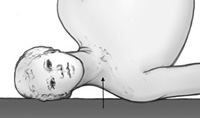
Burners and Stingers
Burners and stingers are common injuries in contact or collision sports. A burner or a stinger is an injury to the nerve supply of the upper arm, either at the neck or shoulder. The injury is named for the stinging or burning pain that spreads from the shoulder to the hand. This can feel like an electric shock or lightening bolt down the arm.
In most cases, burners and stingers are temporary and symptoms quickly go away.
Anatomy
Nerves are like electrical cables that travel through the spinal canal carrying messages between your brain and muscles. The nerves that provide feeling and movement to the arm branch out of the spinal canal at the neck. They join together to form a larger bundle, or cord, of nerves. This cord is called the brachial plexus. All of the nerve supply to the arm runs through this plexus.
CauseAn injury to the brachial plexus can cause a burner or stinger. This often happens when the head is forcefully pushed sideways and down. This bends the neck and pinches the surrounding nerves.
Risk Factors
Contact sports. Athletes who engage in contact sports are more likely to suffer a burner or stinger. In fact, up to 70 percent of all college football players report having experienced a burner or stinger during their 4-year careers.
Burners and stingers often occur with a fall onto the head, such as in a wrestling takedown or a football tackle. In fact, tackling or blocking in American football is the athletic activity that most often causes burners or stingers. Football defensive players and linemen frequently suffer this injury.
Spinal stenosis. In addition to playing contact sports, a small spinal canal may put you at greater risk for a burner or stinger. Athletes with recurrent stingers or burners may have smaller spinal canals than players who do not suffer recurrent injury. This condition is called spinal stenosis.
Symptoms In a fall, nerves can be stretched when the player takes a hit on the top of the shoulder, causing the neck to be driven one way and the arm to be driven the other way.
In a fall, nerves can be stretched when the player takes a hit on the top of the shoulder, causing the neck to be driven one way and the arm to be driven the other way.
Burner and stinger symptoms typically occur in one arm only. They usually last seconds to minutes, but in 5% to 10 % of cases, they can last hours, days, or even longer. The most common symptoms of a burner or stinger include:
- A burning or electric shock sensation
- Arm numbness and weakness immediately following the injury
- A warm sensation
In order to determine whether your injury is a burner or stinger, your doctor will discuss your symptoms and how the injury occurred. Imaging tests, such as x-rays, magnetic resonance imaging (MRI) scans, and nerve studies are not usually needed.
A more extensive examination is needed if you have any of the following symptoms:
- Weakness lasting more than several days
- Neck pain
- Symptoms in both arms
- History of recurrent stingers/burners
Treatment begins by removing the athlete from further injury. Athletes are not allowed to return to sports activity until their symptoms are completely gone. This can take a few minutes or several days. Athletes should never be allowed to return to sports if they have weakness or neck pain.
If you have had recurrent stingers, your doctor may recommend a special neck roll or elevated shoulder pads to wear during sports activities. Examples of special shoulder pads include "spider pads" worn under the shoulder pads or a "cowboy collar" worn on top of shoulder pads.
Although the injury gets better with time, you may need to work with a trainer or therapist to regain strength and motion if the symptoms last for several days.
Source: http://orthoinfo.aaos.org/topic.cfm?topic=A00027
